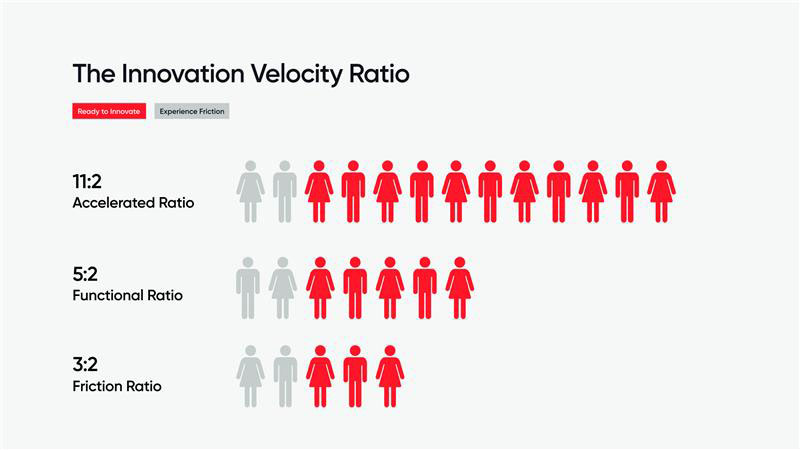Benchmarks & Trends, Benefits, Burnout, Employee Experience
New research reveals the truth behind certain word choice in employee survey comments.
First coined in 1976, golden handcuffs refers to financial allurements and benefits that encourage highly compensated employees to stay at a company - even when they’re miserable.
Telling employee survey research by Great Place To Work® shows that golden handcuffs point to toxic company culture bubbling under the surface.
Defining burnout
World Health Organization (WHO) defines burnout as a syndrome resulting from chronic workplace stress that has not been successfully managed. Workplace burnout occurs when a person feels:
- Limited control of their environment and over their schedule
- Limited participation in decision making and lack of clarity of their work
- Communication is poor, especially with management
Using this definition from WHO, we created a “burnout risk factor index” of nine Trust Index survey statements. When an employee responds positively to only six or fewer statements, they are likely experiencing burnout.
How common is job burnout?
Using this index, we found one-fifth (22%) of employees are burned out, and this has been persistent the last three years. Fortune 100 Best Companies to Work For® and the Best Small & Medium Size Workplaces™ have 6% fewer people experiencing burnout (16%).
Organizations surveyed but who don’t make Best Workplaces™ lists have 5% more people experiencing burnout (27%). This means that the average U.S. workplace has even more people experiencing burnout compared to companies creating a positive employee experience.
Reading between the lines
When Great Place To Work® data scientists analyzed 1,734,443 employee surveys across 1,570 companies to understand how company culture influences job burnout, an interesting trend emerged.
Among employees who were burned-out, “golden handcuffs,” was the top phrase used when answering a question about what makes their workplace great. That’s right — not what makes work awful, but what makes work good.
That this shackled experience manifests in positive feedback, is telling. Employees are sucking up toxic culture out of financial necessity.
The power of golden handcuffs
A lawyer-friend of mine used to describe a work situation that make her feel like she was trapped in “golden handcuffs.”
Her boss was a bully. She lived in fear that her boss would find an omission in the fine print of a client contract. She always bought refundable airfare tickets, and never made plans on a “school night.” I soon learned not to rely on her schedule—I lost count of the number times she had to cancel our Friday night dinner.
Even though the cons kept adding up, she didn’t leave. Her life became the tangible benefits of her job—she could afford the best bedroom in her share house in pricey Sydney and she didn’t think twice about spending like the rest of us, from Uber rides to $600 on designer boots. The biggest carrot on the toxic workplace stick was an eye-watering annual bonus.
Yet she couldn’t stretch through a yoga class without worrying about missing an email. She couldn’t sit through a play without incessantly checking her phone. Her laptop always joined us on weekends away; but most weekends she was either working or too exhausted to socialize anyway.
Reactive and tense, she was in a perpetual state of alert. She had no control over her job.
This constant state of flight or fight is psychologically and physically draining, and bad for employee health.
More insight from employee comments
We learned that among those burned out, “golden handcuffs” was the top phrase used to describe “What makes your workplace a great place to work?”
Additionally, most people who were burned out had little to say or were too burned out to write a response. On average, they wrote 25% fewer words than those who weren’t experiencing burnout.
When asked, “What would make this a better place to work?” people who met the criteria for burnout using our 9 survey statements had more to say. On average, they used 71% more words than those who weren’t burned out.
And the top phrases among those who met the criteria for burnout were:
- “fear retaliation”
- “downward spiral”
- “feel bullied”
- “discrimination”
- “remove favoritism”
These words give clues for the root causes of burnout. It’s clear that long working hours are not solely to blame. Micromanagement, low job control, ignoring psychological needs, and erratic management leads to burn out, as we explored in this blog on fixing experiences that cause burnout.
We can help you asses the health of your company culture.
When it comes to job burnout, the writing is not always on the wall. But analyzing employee feedback can give you a clearer picture of how burnout is impacting your people.
If you want to diagnose burnout in your organization:
- Survey your employees using our Trust Index survey
- Analyze survey results and connect the dots between cause and effect
And friend, if you’re reading this, there’s another way to work – and live. The employee satisfaction scores of Certified™ great workplaces are a great place to start your search.











